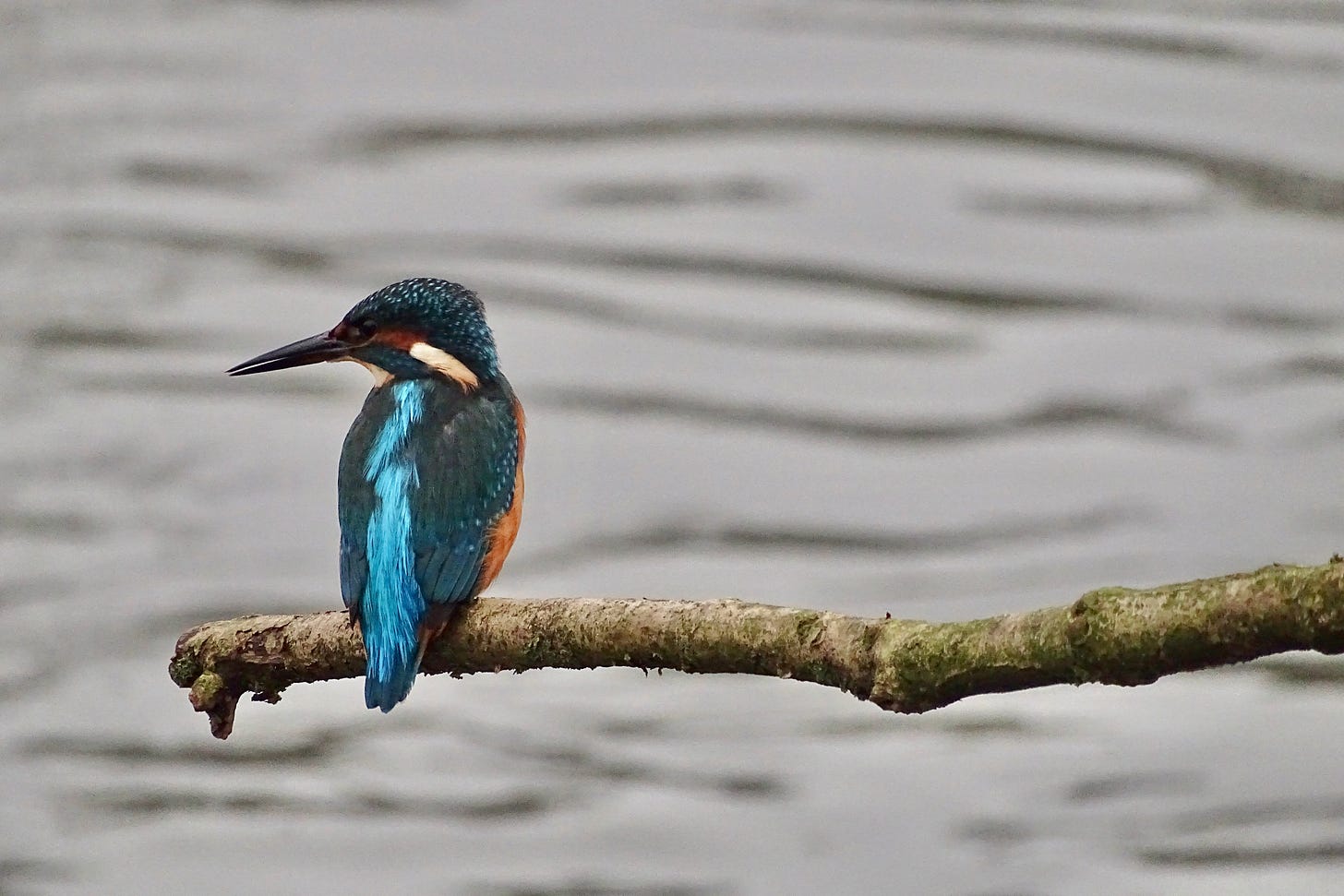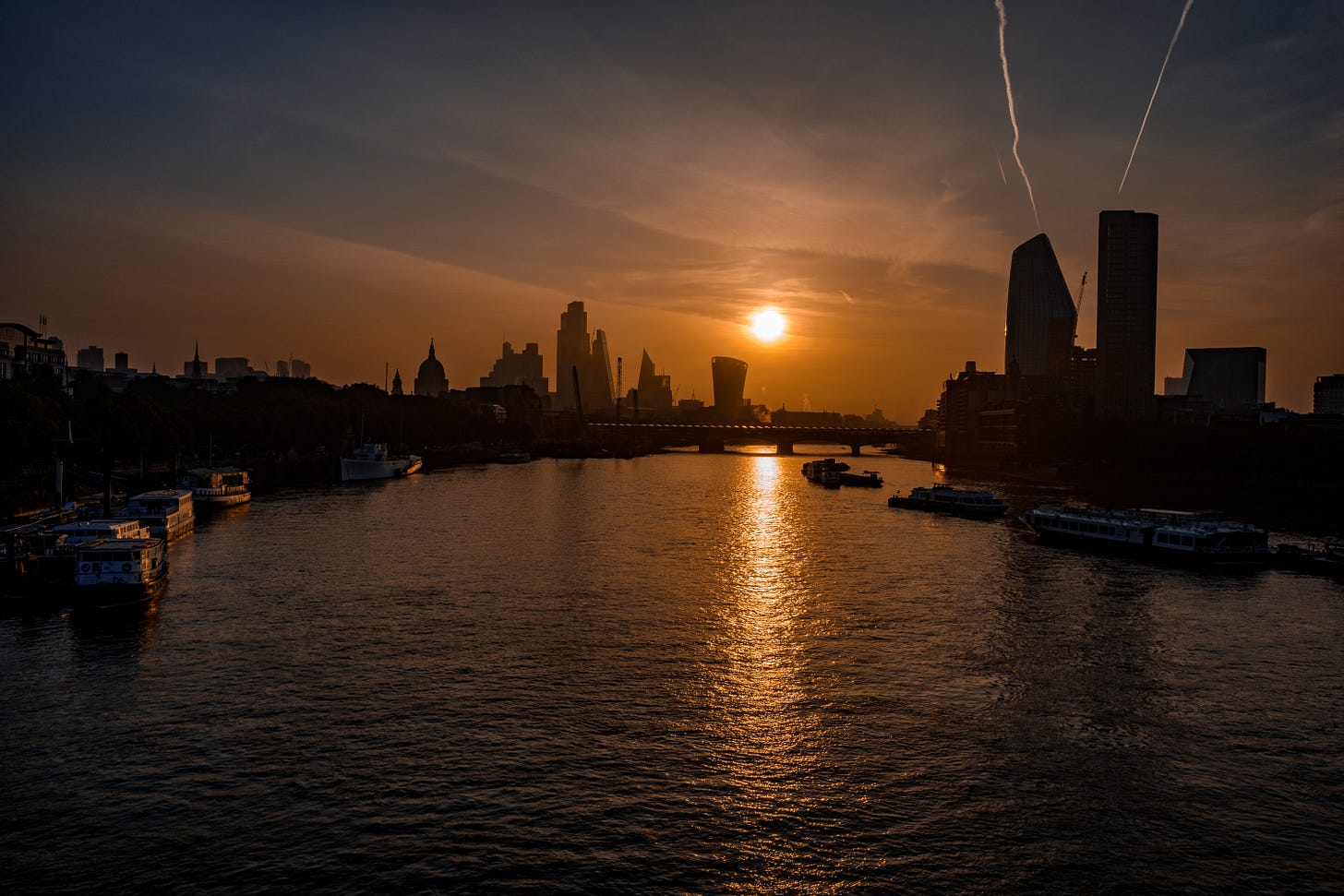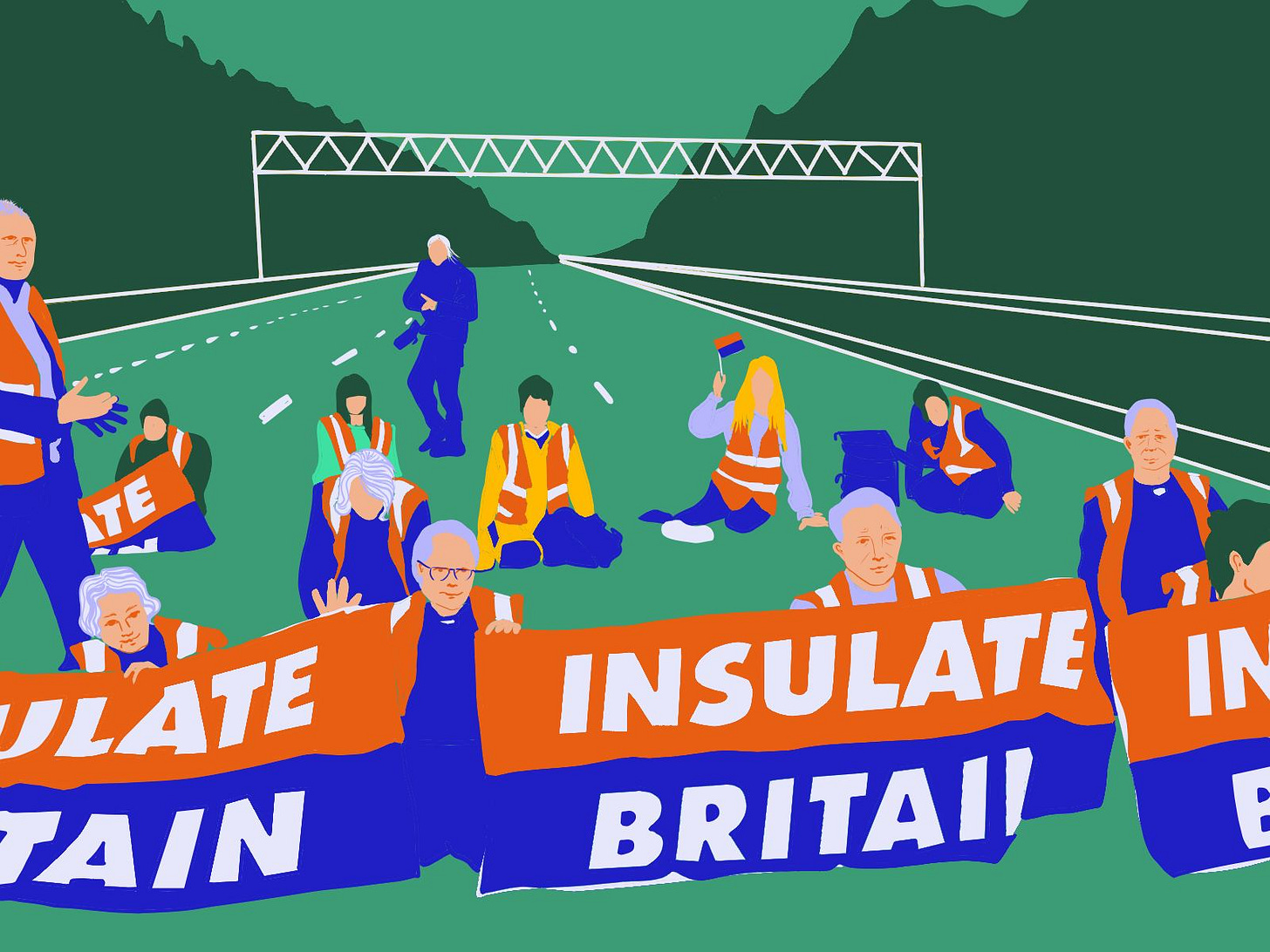Are Insulate Britain's tactics working?
An expert in protest talks everything from radical flank theory to the collective action problem. Plus, urging water companies to take sewage seriously.
🌏 Ours to Save is back with a vengeance after a break. You can expect more positive climate coverage from us over 2022, with a deeper focus on video and visuals. As always, the best way to support us is by becoming a paid subscriber. This will ensure we can keep publishing forward-thinking environmental journalism. 🌏
Insulate Britain and the politics of protest: Interview with Michael Heaney
The author, documentary filmmaker and political scientist tells us what we can expect from the future of climate protest.
Micheal Heaney is a political scientist who specialises in social movements, networks and political parties. Currently a lecturer in Politics and Research Methods at the University of Glasgow, he is the co-author of Party in the Street: The Antiwar Movement and the Democratic Party after 9/11 and co-creator of the documentary The Activists: War, Peace, and Politics in the Streets.
Ours to Save talks to him about his research at COP26 and the tactics of protesters, including Extinction Rebellion and its notorious splinter group Insulate Britain.
Your academic work has focused on protest. Do you think that lobbying governments and public climate protests have the power to influence meaningful political action? Or is this really in the hands of major corporations?
Yes, I think that citizens and their lobbying can definitely make a difference. I think that everything fits together. You laid out three sets of actors here: You’ve got citizens, the government and corporations. These actors are all part of the same system. But they want different things: Politicians want to be re-elected, corporations want to make profits and sell their products, people want better lives for themselves and their families.
You're suggesting that corporations may have more power than citizens do. And part of the reason for that is that it’s hard for citizens to act collectively, whereas it's easier for corporations and governments to act together. As political scientists we call this a ‘collective action problem’.
But it’s definitely possible for citizens to put pressure on the government and then for the government to put pressure on corporations, and likewise, it's possible for citizens to put pressure on corporations and then for corporations to put pressure on the government.
Now, to say it can be done doesn't mean it's done easily; the challenge is getting citizens to put pressure on those two types of actors. Creating that pressure is very challenging; it's doable, but not easy.
Is it in the UK government’s interests to respond to the demands of protestors or are they too invested in supporting corporations, given that net-zero is not yet economically viable?
Well yes, it can be in the government's interest to respond to protesters. It isn't necessarily always in their interest.
It really depends on the relationship between the protests and the political system. So, for example, if you take the current government right now, the Tories have an unchallenged majority in Parliament. The Tories don't have a lot of people among their constituents who care about protest. So, under these conditions, it's easier for the Tory government to ignore the protesters.
Now the other parties that are challenging the Tories, like Labour and the SNP, have more protesters in their constituencies, so those parties are going to listen to the protesters and, of course, it matters how you do the protests.
I think the answer is yes, it can, but it depends on the configuration of the political system and the relationship between the protesters and the government. Right now, the government knows these are not their constituents.
So, there are two options: One option is that those protesters have got to get their people into government so they have more power. Another strategy is to try to get the Tories to listen to them – that's more challenging but that's also a possibility.
Lately, climate activism has been characterised by civil disobedience, primarily from Extinction Rebellion and its splinter group Insulate Britain. What do you think has driven this movement towards direct action?
Hahaha. That’s a super hard question! I think there's no one answer and, actually, I just finished teaching that to a class on social movements. That was a big topic that we talked about all semester.
The short answer is there's no one right answer, it's a complex question. There are a couple of things that drive the turning to civil disobedience and more destructive forms of action:
One is frustration; people feeling like it's an urgent problem and they're not getting an immediate answer. So, frustration leads people to choose the civil disobedience approach.
Another answer is who the people are.
The kind of people who participate in these groups personally or philosophically have a preference for these more disruptive tactics. I like to read books they like to, you know, block intersections.
And the other answer would be that this does get attention. It's actually a relatively easy way to get attention.
And how effective is this as a form of protest?
It's got aspects that are effective, and it's got aspects that are not. The effective part of it is that it does get people's attention. And it does get people talking about it. And even if people don't like the strategies, you can still potentially have positive effects.
So, for example, in my class on social movements, I just got done reading essays and a number of students wrote essays both about Extinction Rebellion and about Insulate Britain.
And some of the students say things like:
“Because I don't think that these disruptive tactics are a good idea, I'm going to do this other thing that’s more positive and more constructive.”
So, actually, one role those disruptive tactics can have is they can inspire people to take other kinds of actions. It is possible that the disruptive people inspire the constructive people.
It's also possible that just by getting the issue on the agenda that it gets more people interested and more people active. Of course, the flip side of it is that people’s lives get interrupted and that bothers them and then they get put off wanting to help the cause. Both of those things are happening at the same time.
There is something in social movement theory called the ‘radical flank effect’. It was invented before I was born.
The idea of a radical flank is that when the radical flank gets mobilised, other power holders don't want to deal with the radical flank so they're more incentivised to deal with more moderate actors.
Say you have Insulate Britain or Extinction Rebellion engage in some kind of really disruptive action like the block intersections. And let’s say I'm a person who thinks we need to do something about climate change, but I don't like that action, I'm not going to say “To hell with Extinction Rebellion, let the planet burn”. I'm not going to say that because I have future generations I care about. But I might not want to work with Extinction Rebellion - I might choose some other approach
So, I think on balance it's good to have it in this as part of the approach, but it can't be the only approach.
In the past, much of your research has been based in the United States. What differences and similarities do you see in the ways in which climate protests are being held and responded to there?
There’s a lot of similarity. You know, part of the difference might be because there's less of an urban-rural divide here, and I think that that urban-rural divide characterises both places. You know in the United States you've got big expanses of land that are sparsely populated. That's not as true here in the United Kingdom. Northern Scotland is not that populated. But I think the United States is a little more rural.
You almost might say that the climate movement is one of those movements that’s such a transnational movement that it has the same arguments, the same concerns and the same tactics in different countries.
Do you think future generations will look back favourably on our efforts to counteract the effects of climate change or do you think they’ll see a culture of entitlement and unchecked greed?
Well, no. Do I think that they'll look back and think we did a good job? No, they won't. I don't think [greed] is the problem either. I think the problem is not knowing how to coordinate a solution.
Ever since I was younger, I can remember people saying “recycle”, “don't waste food”, “don’t waste water”. But these are really not at the heart of the problem.
The heart of the problem is the way that we produce and use energy. Those are the big issues and they're really beyond our control as individuals.
To some extent, greed is involved because the existing companies that depend on fossil fuels have a vested interest in the way that things work now. But there are still technological issues: How are you gonna make green energy profitable – and people don't really know what a good approach is to deal with the problem.
It is a really complex problem because it requires collective action on a global level, and there are all sorts of things that are being managed, like population growth.
For the last 70-years, a big part of the agenda has been development, especially for the developing world by definition. Places like India are growing; China has stemmed its growth, but it's still managing a fairly large population.
So how do you deal with these issues? You want every human being born on the planet to have a good life. You want them to have clean water and medical care. You want every child to be able to grow up to be 86 years old if they can be – or older.
We've got these goals for development and health and wellbeing. And then we've got these goals to manage the overall environmental situation. And then the development issues are being dealt with on a nation-by-nation basis, but environmental issues are global as a whole, it's extraordinarily complex.
So I think this will be looked back at as a period where we didn't really know what the right approach is.
My hope for the next 20 years would be that we can find approaches to try to deal with both of those things at the same time. Either we're gonna find a way to mitigate these problems or we're gonna see increased war. We're going to see increased climate destruction; the question is whether we also see increased starvation and human suffering in war.
The climate summit has also drawn our attention back to several toxic practises; from the pollution of oceans and waterways to the shipment of household waste abroad.
What kind of changes would you like to see the UK government enact over the next five years?
I'm willing to give you my opinion. Everything you've asked me up till now I think fits within my scholarly expertise – on this question I have an opinion as a private citizen.
I think I would like to see that the government – not just in the U. K. but the governments of all the other large nations of the world, including the United States and India and China and Russia – do the following: More public investment in green technologies, more public investment in green fuels.

Right now, the whole system is structured to harness fossil fuels, and so there are vested interests in that. And that's what you refer to as greed, I would call it vested interest. Because those organisations have to advance the interests of their shareholders – that’s what they do. But I think that you need the government to step in and just make it profitable for people to use green energy.
New team member alert! Both of these pieces are by Al Howard, a staff writer at Ours to Save. She’s interested in space, art and saving the planet.
The truth behind England’s Brown Unpleasant Rivers: 160 years of crap
England’s rivers are polluted beyond legal limits. A dive into its murky past suggests that sewage spills from leading water companies are responsible.
As world leaders arrived in Glasgow for the COP26 summit in late September last year, the UK had its bubble burst by a damning internal report on the ecological health of England’s rivers.
This pollution was largely the result of agricultural and industrial run-offs – water from farms and factories which enter rivers through irrigation or rain – and chemicals from household drains. However, half could be traced back to sewage discharges from water companies.
In the days following, the media was choked with stories of poisoned swimmers and sickly wildlife, leaving us all to wonder: Is this such a surprise?
The state of our rivers
‘The State of Our Rivers’ report, conducted by the Environment Agency, was part of a follow-up to a 2016 investigation.
Astonishingly, it revealed that only 14% of England’s rivers were in ‘good ecological condition’ – alongside 65.7% in Scotland, 46% in Wales and 31.3% in Northern Ireland. The study covered wildlife, oxygen levels and chemical pollution, using new sampling methods which tested biological matter extracted from fish and shellfish.

Furthermore, the report found that none were entirely free of chemical pollutants; mercury (a result of pesticide overuse), polyphenyl ether (a dissolvable flame retardant) and P-Phos (a chemical used for waterproofing).
These findings also shed light on neglected government targets, set 20 years ago, which aimed to have three-quarters of England’s water bodies in good condition by 2027.
The main offenders appeared to be sewage treatment facilities and farms, which are legally permitted to release wastewater during bad weather via storm overflows.
Due to population expansion and the effects of climate change, these have exceeded expected limits with 403,171 sewage spills into England’s waterways and seas in 2020 alone – roughly equating to 3.1 million hours of spillages.
These spillages - many of which were unregulated - have caused significant damage to the environment, increasing levels of nitrates in the water, which results in excessive algae growth. This, in turn, reduces oxygen levels and degrades the habitats of existing wildlife.
In response to the report, environment minister Rebecca Pow stated that the government “are absolutely committed to achieving our water quality ambitions,” but also cited the need to “go further and faster on reducing the environmental impact from storm overflows and other sources of pollution including chemicals and agriculture.”
The Great Stink of 1858
River pollution, particularly in urban centres, is hardly a new problem. England’s rivers are historically bad. Really bad.

In fact, one can look back to the River Thames in 1858 to see the effects of sewage pollution in action. Back in the 19th-century, the 200-mile-long river which passes through London was described by Dickens as “a dank, stinking sludge, the scene of murders and crime”. It was essentially an open sewer, transporting all of the city’s unsavoury waste from factories, slaughterhouses, and breweries.
This pollution reached its climax in the particularly hot summer of 1858, which became known as ‘The Great Stink’.
Record temperatures and a lack of rain rendered London unliveable. Concoctions such as chalk lime were poured into the river, scathing caricatures of Old Father Thames were published in the newspapers and letters were members of parliament. But, most of the recipients lived far enough away from the river to escape the smell and the issue was continuously swept under the rug.
It wasn’t until the stench became so overpowering that MPs fled parliament mid-debate, that serious measures were taken.
A solution finally came from Victorian civil engineer Joseph Bazalgette, who designed a sewer system to transport the refuse of London’s rapidly expanding population out of the city. But, after another century of poor urban planning and industrial waste, the stink was back.
The Thames clean-up
In 1950, those unlucky enough to fall into the Thames were sent immediately to the hospital to have their stomachs pumped and very few came out again. Parts of the river were then declared ‘biologically dead’ in 1957, prompting one of the most significant river clean-ups in history.
Today, the Thames is one of a handful of success stories, and, due to a major restoration project by government agencies, NGOs, private companies and community volunteers, it’s considered to be one of the cleanest rivers in the world.
There has been a dramatic increase in the biodiversity of the Thames Estuary and the river now supports 125 species of fish and over 400 species of invertebrates. Meanwhile, seals, seahorses and wading birds have returned to the Tidal Thames.

So, how did this happen?
In the 1960s, new sewage treatment plants were installed and existing systems were updated to prevent spills into the river – enabling more oxygen to enter the water and the ecosystem to recover. This was supported by a ban on industrial discharges into the river and a transition to eco-friendly disinfectants which came with the ecological awakening of the 1970s.
Tackling sewage leaks remains key to the preservation of the river. The Tideway Scheme was designed for this purpose: A 25km ‘super sewer’ is being built at the Falconbrook treatment plant in Wandsworth, which currently spills 700,000 cubic metres of untreated sewage into the river each year.
This further £4.2B update to Bazalgette’s overburdened 150-year-old system would reduce these leaks by 94%.
Thames21
Community-driven initiatives have also been, and remain, fundamental. At the forefront of these schemes are beach clean-ups where teams of volunteers remove litter that could choke or ensnare wildlife. This also prevents plastic from breaking down into microplastics which wreak havoc on the food chain.
Thames21, a non-profit organisation, holds regular campaigns and beach clean-ups to reconnect people with the environment. Its aim is “to rebuild the relationship between communities and their rivers; restoring river health and boosting wellbeing and community cohesion in the process.”
But the organisation recognises that this is only a short-term solution. It suggests we redirect our energy to where waste is coming from to create lasting change:
“Thames21 is calling for people, government and business to transform the way we produce, use and dispose of plastic waste.”
The Tyne
The Tyne, the 73-mile river which runs through Northeast England, is another success story. Like the Thames, sections of the river were so corrupted with sewage by the 1950s that the water could no longer support salmon. One contemporary report stated:
“The concentration and semi-stagnation of polluting matter make the upper portion of the estuary virtually into a septic tank.”

However, the installation of sewage treatment plants and community efforts have since restored the river to the best salmon and trout fishing river in England and Wales.
This conservation is continued by the Tyne Rivers Trust, an environmental charity committed to the preservation of the river and its wildlife. Formed in 2004, it currently runs projects between Alston and Keilder to Tynemouth, opening up the river to migrating fish species and educating local farmers on practical solutions to overflows which leak toxic fertilisers and pesticides into the waterways. These solutions include clean and dirty water separation, and the incorporation of hedges and buffer strips to reduce run-off.
The future of our rivers
New data released this week by the Financial Times has exposed that since the privatisation of the sector in 1989, investment in wastewater disposal has been slashed by 20%, despite higher household water bills.
This follows the rejection of a strict anti-sewage amendment by Commons in November. The proposed amendment to the Environment Bill, drafted in the House of Lords, was designed to protect the rivers from sewage released during storm flows.
Whilst a compromise was eventually reached, a number of NGOs have voiced concerns that the 8th November amendment has failed to impose a legal duty on water companies, nor does it propose a set deadline for reducing spills.
One such voice has come from Windrush Against Sewage Pollution, a group of volunteers investigating the pollution of the river Windrush, a tributary of the Thames.
As vocal critics of the current system, WASP blame the water companies for the current quality of England’s rivers, arguing that under current regulations “it’s more profitable [for water companies] to pollute than to act sustainably.”
“In 2020, Thames Water reported profits of £244.6 million after tax. As a whole, the water industry has made around £60 billion since being privatised,” their website states.
“They continue to pollute - both legally and illegally - but there is little incentive to fix the problem. The Environment Agency’s prosecutions ignores many offences.”
What can we learn?
As the Thames and Tyne clean-ups demonstrate, it is possible to restore heavily degraded ecosystems. These success stories provide a blueprint for other degraded waterways: Primarily, the importance of better education on the effects of pollutants, engagement in community-led clean-ups, and in investment wastewater infrastructure.

It's also important to remember that many of England’s rivers have undergone positive change, as ‘The State of Our Waters’ report demonstrates:
‘Most of the progress we have seen has happened because of stronger laws, better practice, public pressure, investment by the water companies, action by environmental NGOs, and effective regulation by the Environment Agency.’
However, improvements made in the 70s and 80s, which oversaw the restoration of major rivers such as the Thames and the Tyne, have been hindered by cuts made by water companies post-privatisation. This has resulted in failure to invest in new sewers, pipes and treatment plants to counteract the increasing pressures of climate change and population growth.
But, these problems are not exclusive to densely populated areas - water pollution has far-reaching consequences. England is home to 85% per cent of the world’s chalk streams, unique habitats that host a number of rare species - from otters and water voles to kingfishers, which are already at risk from rising water levels and extreme weather.
Looking forward, the health of all of our rivers is dependent on new legislation which will close loopholes and oversee the prosecution of water companies responsible for illegal sewage spills. Meanwhile, community enterprises such as WASP must rise to the challenge of preserving their own rivers through educational programmes, community beach clean-ups and lobbying for better regulation of water companies.
Unfortunately, in this regard, it appears that in order to create actionable change, the UK's governing bodies will firstly have to smell the stink.
Visit Windrush Against Sewage Pollution to get involved in their campaign against water contamination.






